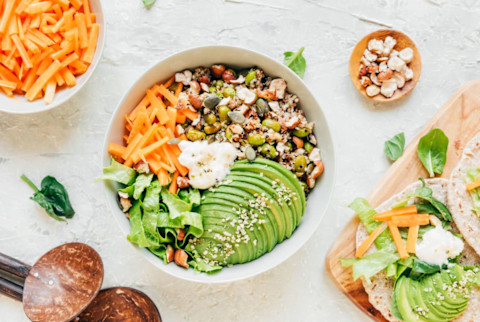Low-Carb? High-Protein? How To Choose The Best Base For Your Grain Bowl

Bowl meals are tasty and convenient—whether you’re opting for a classic burrito bowl or one with a Mediterranean flair. Just throw your favorite carb, protein, and fat together and you've got a balanced meal.
Somewhere along the way, we’ve limited the carb portion of these meals to mainly rice. But there are so many other options that may suit your taste buds and health preferences more.
Here are a few suggestions to spark your creativity.
Best for high-fiber: Bulgur
If you’re looking to boost the fiber content of your bowl without much extra effort, bulgur is a smart pick. This whole grain is made from cracked wheat that’s been parboiled and dried, so it cooks up quickly and retains its chewy, slightly nutty texture. Just half a cup of cooked bulgur delivers over 4 grams of fiber. That’s about double the fiber in the same amount of brown rice. As nearly 95% of Americans aren't getting enough fiber each day, bulgur is a smart addition to a meal.
How to use it: Bulgur’s mild flavor makes it incredibly versatile. It’s a classic base for Mediterranean-inspired bowls (think falafel, hummus, roasted veggies, and a drizzle of tahini). Or, toss it warm into a salad bowl with chopped herbs, feta, and lemon for a tabbouleh twist.
How to prep: Bulgur cooks up in just 12 minutes on the stovetop.
RELATED READ: 10 Types Of Protein To Complete Your Lunch Bowl
Best low-carb: Cauliflower rice
If you’re watching your carb intake or just want to sneak in more veggies, cauliflower rice is a solid go-to. With just about 2 grams of carbs per half cup (compared to the 22 grams you’d get from white rice) it’s a simple swap that lightens up any bowl without sacrificing bulk. It has a pretty neutral taste and often soaks up all the flavors of everything else in your bowl. If the texture isn't your favorite or you do want a slightly higher carb intake, you can always mix cauliflower rice with brown rice.
How to use it: Cauliflower rice pairs nicely with most foods and spices. It personally wouldn't be my favorite for a sushi roll-inspired bowl.
How to prep: Keep a bag of frozen cauliflower rice in your freezer for busy nights. Steam it on the stovetop or microwave it straight from frozen. For extra flavor, sauté it with garlic, onion, or your favorite spices before serving.
Best high-protein: Lentils
Lentils aren’t just for soups and stews, they’re a great grain-alternative for protein-packed bowls. Half a cup of cooked lentils delivers about 9 grams of protein, that’s triple the amount in the same serving of rice. They also have about 8 grams of fiber per serving. While lentils aren't the main source of protein in your bowl, they do offer a meaningful boost to the meal.
How to use it: Stir cooked lentils into a bowl with roasted veggies, grains, or leafy greens. They add hearty texture and soak up dressings beautifully. To complete the high-protein meal you're going for, pair them with chicken, shrimp, or salmon.
How to prep: Simmer lentils in water or broth for 20–30 minutes. Make a big batch at the start of the week and keep them in the fridge to use throughout the week. They’re ready to scoop into any bowl, warm or cold.
Best grain-free: Potatoes
Potatoes can do it all—including serving as the carb portion of your bowl meal. They’re naturally filling and bring plenty of volume to your meal without a high carb count. About half of a medium potato has about 15 grams of carbs.
Plus, when cooked and cooled (or even partially cooled), potatoes form resistant starch, a type of carb that acts more like fiber in your gut, supporting digestion and feeding healthy gut bacteria. They’re also rich in potassium, which many people don’t get enough of.
How to use it: They work particularly well for breakfast bowls with overeasy eggs, steak and veggie bowls, or even taco bowls..
How to prep: Slice, dice, chop, or mash a batch of potatoes at the beginning of the week.
RELATED READ: 5 Genius Ways To Make A Meal Out Of Sweet Potatoes
The takeaway
If you're bored or using rice in all your bowl meals, it's time to switch things up. Other carb options (like bulgur, cauliflower rice, lentils, and potatoes) can add more texture, flavor, and nutrition to meals. There are endless combinations to play around with.
